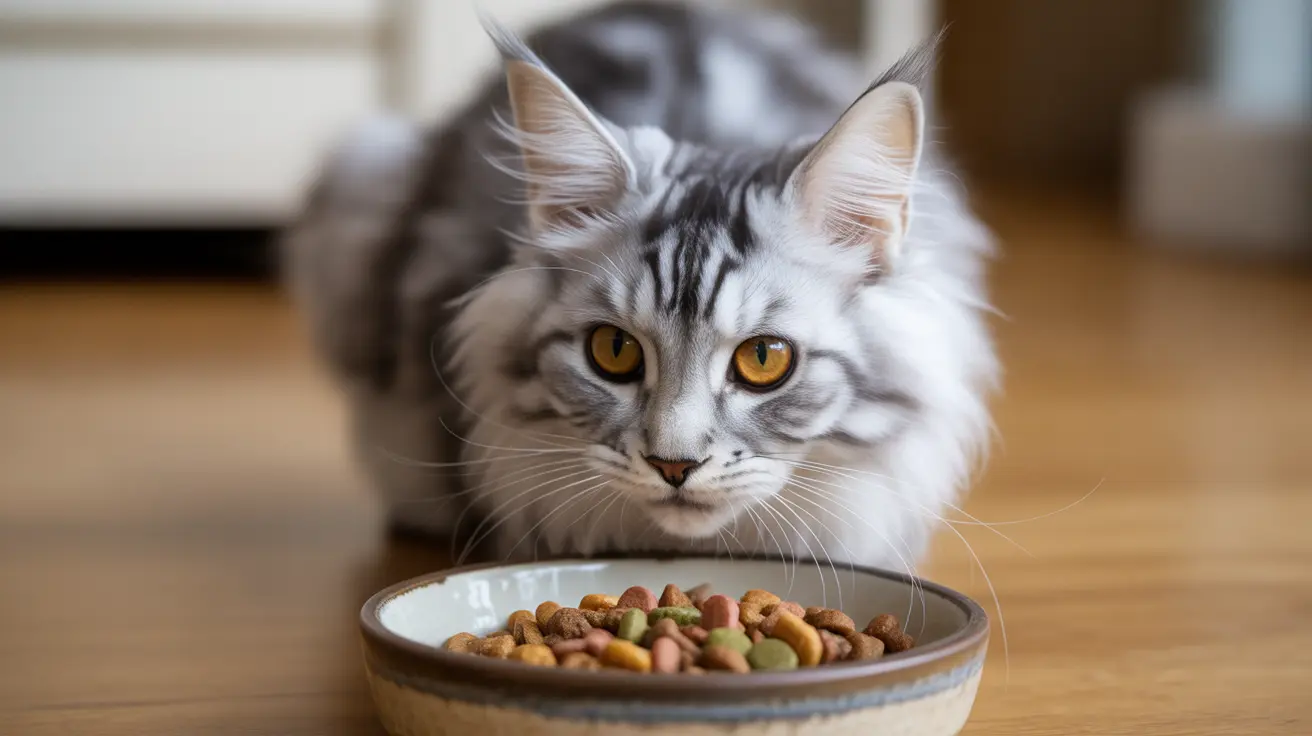Complete Guide to Cat Food Allergy Management: Diagnosis, Treatment, and Long-Term Care
Food allergies in cats are more common than many pet owners realize, affecting felines of all ages and breeds with potentially serious health consequences if left untreated. Unlike seasonal allergies or environmental sensitivities, cat food allergy management requires a systematic approach involving elimination diets, careful monitoring, and lifelong dietary modifications. Understanding how to identify, diagnose, and properly manage these immune-mediated reactions is crucial for maintaining your cat's health and quality of life.
When a cat's immune system mistakenly identifies a harmless food protein as a threat, it triggers an allergic response that can manifest through various uncomfortable symptoms ranging from persistent itching to digestive issues. The complexity of food allergies lies not only in their diverse symptom presentation but also in the fact that they cannot be diagnosed through conventional allergy tests, making proper cat food allergy management a collaborative effort between pet owners and veterinary professionals.
Understanding the Science Behind Food Allergies in Cats
Food allergies in cats occur when the immune system overreacts to specific food ingredients, most commonly proteins. This immunological response involves the production of antibodies that recognize certain food components as foreign invaders, triggering inflammatory reactions throughout the body. Unlike food intolerances, which do not involve the immune system, true food allergies create a cascade of immune-mediated responses that can affect multiple organ systems.
The most common food allergens in cats are animal proteins, particularly beef, chicken, and fish. These proteins are frequently used in commercial cat foods, making exposure inevitable for most cats. Other less common allergens include lamb, rabbit, egg, dairy products, and plant-based ingredients such as wheat, barley, corn, soy, and various artificial additives. The prevalence of these ingredients in mainstream pet foods explains why they become common triggers for allergic reactions.
What makes food allergies particularly challenging is that they can develop at any age, even if a cat has been consuming the same diet for years without problems. Genetic predisposition plays a significant role in determining which cats will develop food allergies, and these conditions are often associated with other allergic conditions such as atopy (environmental allergies).
Recognizing Food Allergy vs. Food Intolerance
Distinguishing between food allergies and food intolerances is essential for proper cat food allergy management, though both conditions can present similar clinical signs. Food allergies involve immune system activation and antibody production, while food intolerances are non-immunologic reactions that typically involve digestive enzyme deficiencies or sensitivities to food additives.
The symptoms of both conditions often overlap significantly, making clinical differentiation challenging without proper diagnostic procedures. Both can cause gastrointestinal upset, skin problems, and behavioral changes. However, food allergies tend to produce more consistent and severe reactions, even with minimal exposure to the offending ingredient, while food intolerances may vary in severity based on the amount consumed.
Identifying Symptoms of Food Allergies in Cats
The symptoms of food allergies in cats primarily manifest as chronic skin problems and gastrointestinal disturbances. The most common signs include persistent itching and skin lesions that typically affect the head, neck, face, ears, belly, groin, armpits, legs, and paws. Affected cats often display compulsive behaviors such as excessive licking, scratching, biting, and overgrooming, which can lead to secondary skin damage.
Dermatological manifestations include miliary dermatitis (small crusts scattered across the skin), redness, papules, self-induced trauma resulting in open sores, patchy hair loss, ulcerations, and raised plaques. These skin changes are often accompanied by recurrent bacterial or yeast infections that may require separate antimicrobial treatment.
Less commonly, cats with food allergies experience gastrointestinal symptoms such as chronic vomiting, diarrhea, scooting behavior, and inflammatory bowel disease. Some cats may also develop recurrent ear infections that fail to respond completely to standard treatments. The chronic nature of these symptoms, particularly their persistence despite conventional treatments, often provides the first clue that food allergies may be involved.
The Gold Standard: Elimination Diet Protocol
Proper diagnosis of food allergies relies exclusively on conducting a carefully controlled elimination diet trial lasting at least eight weeks. This diagnostic approach is considered the gold standard because commercial serum, saliva, or hair testing for food allergies is not reliable and is not recommended by veterinarians.
During the elimination diet phase, cats are fed a strict diet containing either novel proteins (proteins they have never been exposed to before) or hydrolyzed proteins. Veterinary hydrolyzed protein diets contain proteins that have been broken down into molecules too small to trigger immune reactions, while novel protein diets introduce entirely new protein sources such as venison, duck, or rabbit.
The success of an elimination diet depends entirely on strict adherence to the prescribed protocol. No other treats, supplements, flavored medications, or exposures to non-prescribed foods should occur during the trial period. Even small amounts of forbidden ingredients can interfere with results and extend the diagnostic timeline.
Conducting a Successful Provocation Diet
After completing the eight-week elimination phase, a provocation or challenge diet is introduced to confirm the diagnosis. This involves systematically reintroducing suspected allergens while carefully monitoring for symptom recurrence. If symptoms return upon reintroduction of the original diet, this confirms a diagnosis of food allergy and identifies the specific triggering ingredients.
The provocation phase should only be conducted under veterinary supervision, as it intentionally exposes the cat to potential allergens. This step is crucial for definitively identifying which specific ingredients must be avoided for lifelong management.
Long-Term Management Strategies
Successful cat food allergy management requires lifelong dietary modifications and ongoing vigilance. Once triggering allergens are identified, affected cats must maintain strict avoidance of these ingredients throughout their lives, as food allergies are not curable conditions.
Prescription veterinary diets are strongly preferred for long-term management due to their strict quality control measures that prevent cross-contamination with allergenic ingredients. While some retail foods may be labeled as limited-ingredient or allergen-free, they often lack the rigorous safety protocols necessary to prevent accidental exposure to triggering proteins.
Pet owners must also be vigilant about treats, supplements, and flavored medications, ensuring all food items are compatible with their cat's restricted diet. Reading ingredient labels becomes a critical skill for maintaining successful management.
Working with Your Veterinarian
Effective cat food allergy management requires close collaboration with veterinary professionals who can design custom dietary plans tailored to each cat's specific needs. Veterinarians can recommend appropriate prescription diets, monitor progress during elimination trials, and provide symptomatic treatment when necessary.
During dietary transitions or symptom flare-ups, veterinarians may prescribe low-dose corticosteroids to provide temporary relief while dietary adjustments take effect. Secondary bacterial or yeast infections that commonly occur with food allergies require appropriate antimicrobial therapy under veterinary guidance.
Nutritional Considerations During Treatment
Maintaining proper nutrition during elimination diet phases requires careful attention to ensure cats receive all essential nutrients while avoiding allergenic ingredients. Veterinary prescription diets are formulated to meet complete nutritional requirements while providing hypoallergenic protein sources.
Home-prepared diets formulated by veterinary nutritionists may be appropriate in some cases but require professional guidance to ensure nutritional adequacy. The restriction of multiple protein sources can potentially limit nutritional options, making professional dietary planning essential for long-term health.
Potential Complications of Untreated Food Allergies
Food allergies that remain undiagnosed and untreated can lead to serious secondary complications affecting multiple body systems. Chronic skin inflammation can result in permanent scarring, bacterial infections, and compromised skin barrier function. Persistent scratching and overgrooming can create open wounds that become infected, requiring extensive medical treatment.
Gastrointestinal symptoms can progress to inflammatory bowel disease, malabsorption, and nutritional deficiencies if left untreated. The chronic stress and discomfort associated with untreated food allergies can also negatively impact a cat's overall quality of life and behavioral well-being.
Specialized Dietary Solutions
Modern veterinary nutrition offers several specialized dietary approaches for cat food allergy management. INTEGRA PROTECT SENSITIVE by animonda represents one example of professionally formulated elimination and maintenance diets designed specifically for allergic cats. These specialized diets feature single animal and plant protein sources without grain proteins, are gluten-free, and are developed by veterinarians specifically for managing food allergies and intolerances.
Such specialized diets typically offer high acceptance rates and are available in multiple flavors and forms, including both wet and dry options, to accommodate different cat preferences while maintaining strict allergen control.
Frequently Asked Questions
Can cats suddenly develop food allergies to foods they've eaten for years?
Yes, cats can develop food allergies at any age, even to foods they have consumed safely for years. The immune system can become sensitized to proteins over time, leading to allergic reactions despite previous tolerance. Genetic predisposition plays a significant role in determining which cats will develop food allergies.
Are blood tests or saliva tests reliable for diagnosing food allergies in cats?
No, commercial serum, saliva, or hair testing for food allergies is not reliable and is not recommended by veterinarians. The only accurate method for diagnosing food allergies in cats is through a carefully controlled elimination diet trial lasting at least eight weeks, followed by a provocation diet.
What are the most common food allergens that affect cats?
The most common food allergens in cats are animal proteins, particularly beef, chicken, and fish. Other allergens include lamb, rabbit, egg, dairy products, and plant-based ingredients such as wheat, barley, corn, soy, and various artificial additives commonly used in commercial pet foods.
How long does an elimination diet need to last to be effective?
An elimination diet must last at least eight weeks to allow sufficient time for existing allergens to clear from the cat's system and for symptoms to resolve. Some cats may require longer periods before showing improvement, and the diet must be followed strictly with no deviation from prescribed foods.
Can food allergies in cats be cured?
No, food allergies in cats cannot be cured. They are lifelong conditions that require permanent dietary management through strict avoidance of identified allergens. However, with proper cat food allergy management, affected cats can live long, healthy, and comfortable lives.
Is it safe to use over-the-counter limited-ingredient diets for cats with food allergies?
While some retail foods are labeled as limited-ingredient or allergen-free, prescription veterinary diets are strongly preferred due to their strict quality control measures that prevent cross-contamination. Retail foods often lack the rigorous safety protocols necessary to prevent accidental exposure to triggering proteins.
What should I do if I suspect my cat has a food allergy?
If you suspect your cat has a food allergy, contact your veterinarian for a thorough examination, proper diagnosis, and formulation of an appropriate dietary plan. Professional veterinary guidance is essential for conducting elimination diets safely and effectively while maintaining your cat's nutritional health.
Conclusion
Successful cat food allergy management requires a comprehensive understanding of the condition, commitment to proper diagnostic procedures, and lifelong dietary vigilance. While the elimination diet process can be challenging and time-consuming, it remains the only reliable method for accurately diagnosing food allergies in cats. The investment in proper diagnosis and management pays significant dividends in improved quality of life for affected cats.
With appropriate veterinary guidance, strict adherence to prescribed diets, and ongoing monitoring, cats with food allergies can enjoy long, healthy lives free from the uncomfortable symptoms that plague untreated cases. The key to success lies in early recognition of symptoms, professional diagnosis through elimination diets, and unwavering commitment to lifelong dietary management strategies.





